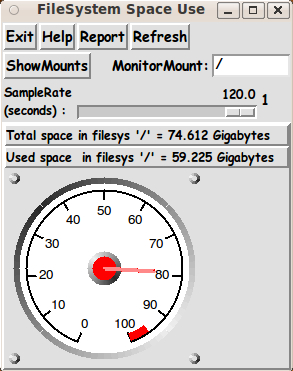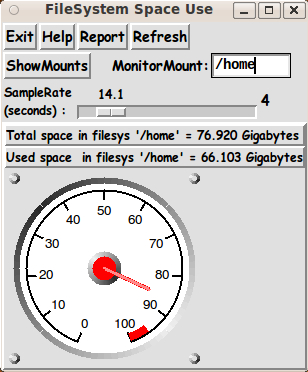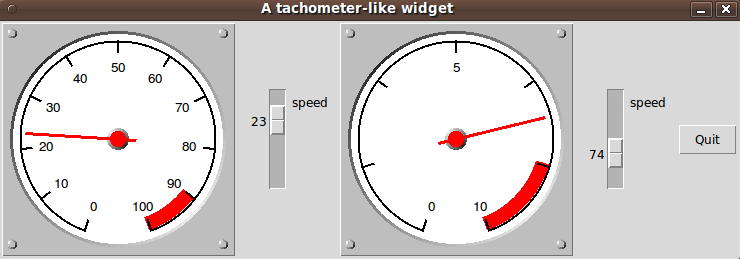|
In this case, you can see that there are two major file systems
(/dev/sd*) on this computer --- 'Mounted on' the root (/) and
home (/home) directories.
On this computer, there are two separate 80 Gigabyte disk drives ---
one used for the 'root' file system, and one used for the 'home'
file system.
However, on many home computers, there is only one
major file system --- the 'root' file system.
---
Goals for the GUI
So in designing this GUI, I decided to go with a single meter on the
GUI --- rather than 2 meters, like in the 'memory-and-swap' and the
'network-activity' Tk GUI's that I had devised before.
Besides showing a 'percent-usage' meter (on a Tk canvas on the GUI),
I wanted to provide a means for the user to query the mount points available
on the computer --- and to choose one of the mount points to monitor.
And I wanted to provide a Tk 'scale' widget on the GUI, by which the user
can specify, at any time, a new 'sampling rate' --- for getting the
usage data via the 'df' command.
(Actually, the 'sampling rate' is a 'wait-time' = 'wave-length',
rather than a 'frequency'.)
I was able to implement that ability by use of the Tcl 'after' command,
in the form
after $WAITmillisecs update_needles
This command is called once to initialize the GUI --- and it is called
within the 'update_needles' proc, to continue getting storage-space
usage data for a user-specified mount point via the 'df' command.
Since, typically, the '%-used' storage space of a large file system
is changing very gradually, a sampling rate larger than a minute or
two may suffice for most needs.
So the scale is initialized at a sampling-rate of that magnitude.
I also wanted to supply a 'Refresh' button on the GUI, so that the
user can request at ANY TIME, a new query of the usage data for the
file system being monitored.
And, in case there is more than one file system that is 'near-full',
I wanted to supply a 'Report' button on the GUI, so that the user
can see, at any time, the usage of ALL the file systems on the computer.
In putting together the code for this GUI, I drew heavily on the
'shadow-circle' technique of Marco Maggi to make nice looking meters.
And I included a 'red-line' (danger) area on the meter, like he did.
One rather unique thing about this implementation of the meter
(something not done by Maggi in his demo) is that the GUI window
and the canvas and the meter are resizable.
In other words, I spent quite a bit of effort in converting
Maggi's procs
So the user is able to resize the window and click on the
'Refresh' button to get a bigger version of the meters and
the needle position.
After several iterations, during which I decided on implementing
the features described above, I ended up with the GUI seen
in the following image.

When the GUI first comes up, the 'Mount-to-monitor' is defaulted to
the 'root' file system --- since that file system is defined on
all of the target computers of this utility.
Below is an image that shows that one can change the 'Mount-to-monitor'
entry field so that a different file system is monitored --- in this
case the 'home directories' file system mounted at /home.

The 'ShowMounts' button on the GUI can be used to show the available
mount points.
A small window pops up showing a list of mount directories.
---
To enlarge the meter
When the GUI first comes up, the meter (its canvas) is sized
at about 200x200 pixels --- and the data shown is based on an initial
execution of the 'df' command --- from which data for the
'root' file system is extracted.
You can see the 'SYSTEMtools' tkGooie page titled
'A Pair of Tachometer-style Meters --- for Memory and Swap'
to see an example image that demonstrates that
the user is able to resize the window and click on the
'Refresh' button to get a bigger version of the meter(s) and
the needle position.
---
Anti-aliasing (jaggies)
I had hoped to come up with a technique to avoid the 'aliasing'
effect on the needles --- but I did not do it for the
'memory-and-swap' script --- and I have still not done that for
the 'network-activity' script and this script.
However, as 'retina display' monitors come into use more and more
(with resolutions above about 2000x1500 pixels), even without changing
the needle-drawing code in this script, you may find that the
'jaggies' are hard to see.
(I do not have such a monitor yet, so I cannot say for sure.)
CAPTURING THE GENERATED IMAGE:
When you get an image that you want to save --- for example, the
images that I posted above to show some GUI features of this utility
--- a screen/window capture utility (like 'gnome-screenshot' on Linux)
can be used to capture the GUI image in a PNG or GIF file, say.
If necessary, an image editor (like
'mtpaint' on Linux)
can be used to crop the window capture image.
The image could also be down-sized --- say to make a smaller image
suitable for presentation in an email or on a web page.
DESCRIPTION OF THE CODE
Below, I provide the Tk script code for this
'file-system percent-used' display utility.
I follow my usual 'canonical' structure for Tk code
for this Tk script:
|



